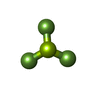+Search query
-Structure paper
| Title | Autoinhibition and regulation by phosphoinositides of ATP8B1, a human lipid flippase associated with intrahepatic cholestatic disorders. |
|---|---|
| Journal, issue, pages | Elife, Vol. 11, Year 2022 |
| Publish date | Apr 13, 2022 |
 Authors Authors | Thibaud Dieudonné / Sara Abad Herrera / Michelle Juknaviciute Laursen / Maylis Lejeune / Charlott Stock / Kahina Slimani / Christine Jaxel / Joseph A Lyons / Cédric Montigny / Thomas Günther Pomorski / Poul Nissen / Guillaume Lenoir /    |
| PubMed Abstract | P4-ATPases flip lipids from the exoplasmic to the cytosolic leaflet, thus maintaining lipid asymmetry in eukaryotic cell membranes. Mutations in several human P4-ATPase genes are associated with ...P4-ATPases flip lipids from the exoplasmic to the cytosolic leaflet, thus maintaining lipid asymmetry in eukaryotic cell membranes. Mutations in several human P4-ATPase genes are associated with severe diseases, for example in causing progressive familial intrahepatic cholestasis, a rare inherited disorder progressing toward liver failure. ATP8B1 forms a binary complex with CDC50A and displays a broad specificity to glycerophospholipids, but regulatory mechanisms are unknown. Here, we report functional studies and the cryo-EM structure of the human lipid flippase ATP8B1-CDC50A at 3.1 Å resolution. We find that ATP8B1 is autoinhibited by its N- and C-terminal tails, which form extensive interactions with the catalytic sites and flexible domain interfaces. Consistently, ATP hydrolysis is unleashed by truncation of the C-terminus, but also requires phosphoinositides, most markedly phosphatidylinositol-3,4,5-phosphate (PI(3,4,5)P), and removal of both N- and C-termini results in full activation. Restored inhibition of ATP8B1 truncation constructs with a synthetic peptide mimicking the C-terminal segment further suggests molecular communication between N- and C-termini in the autoinhibition and demonstrates that the regulatory mechanism can be interfered with by exogenous compounds. A recurring (G/A)(Y/F)AFS motif of the C-terminal segment suggests that this mechanism is employed widely across P4-ATPase lipid flippases in plasma membrane and endomembranes. |
 External links External links |  Elife / Elife /  PubMed:35416773 / PubMed:35416773 /  PubMed Central PubMed Central |
| Methods | EM (single particle) |
| Resolution | 3.1 Å |
| Structure data | EMDB-13711, PDB-7py4: |
| Chemicals |  ChemComp-MG:  ChemComp-BEF:  ChemComp-Y01:  ChemComp-NAG: |
| Source |
|
 Keywords Keywords | MEMBRANE PROTEIN / lipid transporter autoinhibition P-type ATPase P4-ATPase CDC50A |
 Movie
Movie Controller
Controller Structure viewers
Structure viewers About Yorodumi Papers
About Yorodumi Papers





 homo sapiens (human)
homo sapiens (human)